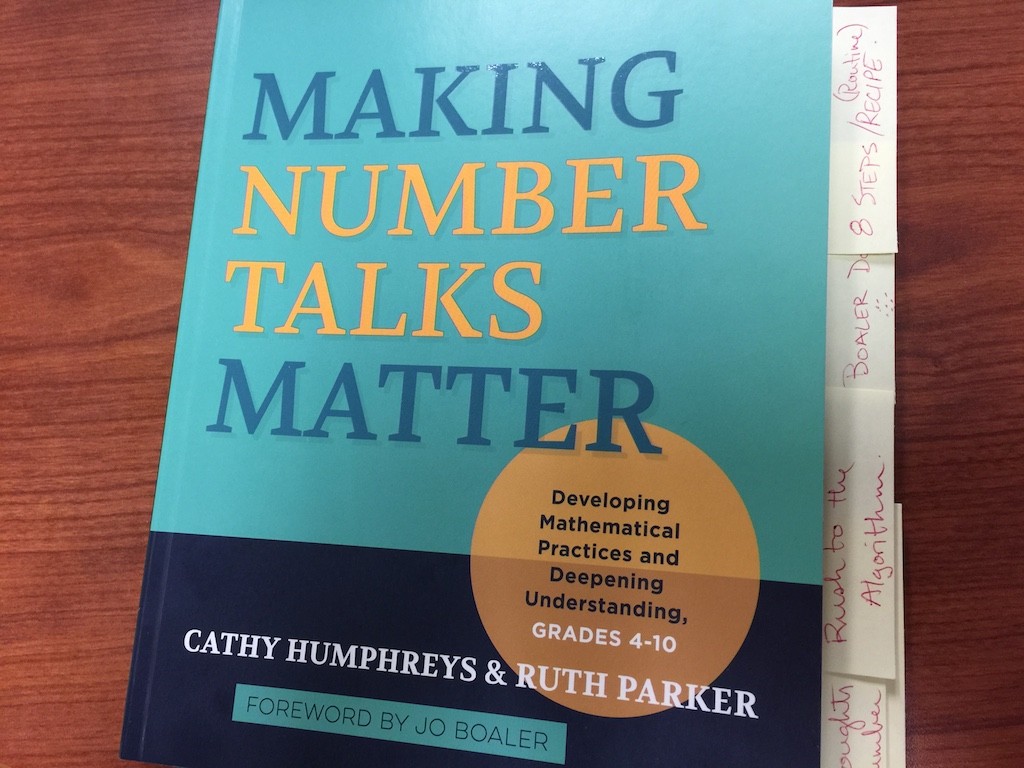Developing Mathematical Practices and Deepening Understanding, Grades 4-10
Cathy Humphreys and Ruth Parker
Mathematics Professional Reading
In my district, Number Talks: Helping Children Build Mental Math and Computation Strategies, Grades K-5 by Sherry Parrish has been a major resource for our primary and junior teachers to promote proficiency and fluency in number sense and numeration for the past five years. Now, Cathy Humphreys and Ruth Parker – who provided words of praise for Parrish in the front matter of her book – have released a book of their own with a focus on grades 4 to 10.
For those keeping track, Parker is one of the creators of Number Talks back in the early 1990s, and Humphries is known for her work extending them to intermediate and senior grades. Now, they have come together to continue the Number Talk love in the junior and intermediate grades on a quest to deepen student understanding and proficiency with number.
Jo Boaler writes in the foreword:
Teachers can watch a video of an expert teacher giving a Number Talk and believe that they are simple to teach, because they can appear deceptively easy. Yet when teachers begin to teach Number Talks themselves, many questions arise: What do they say when students share an incorrect solution, or when there is a mistake in their work? What do teachers do when students have no methods to share? How do teachers know the best problems to use for Number Talks? Where do they find examples of Number Talks for middle and high school students? These questions, and many more, are answered in this book.
In the first chapter, the authors explain what Number Talks are and why they are so important. They highlight some of the many student struggles in math and attribute them to how arithmetic is often taught as a set of rules and procedures to be remembered rather than concepts to be understood. With this, they are also quick to give respect to algorithms for their importance as reliable and efficient tools necessary to learn over time. However, they discourage a rush to the algorithm due to the “compactness” of algorithms that “hides the meaning and complexity of the steps involved” as quoted by the Hyman Bass work Computational Fluency, Algorithms, and Mathematical Proficiency, 2003. They give simple examples such as adding fractions, employing the subtraction algorithm, and even algebraic concepts such as expanding a perfect-square binomial.
The authors move on to presenting the reader with what is “as close to a recipe as you will find in this book” through an 8 step routine that can be used to facilitate an effective number talk in the classroom. With each step includes rationale and some key tips to remember, which are compact enough for teachers to keep in their daily lesson plan. Teachers are encouraged to begin using dot cards as a starting point as this is very non-threatening for teachers and students and can still provide an opportunity to share mathematical thinking through the use of numerical expressions incorporating different operators and their appropriate order. After providing teachers with an exemplar and a transcript to model the specific Number Talk, there are key ideas to promote successful use of Number Talks in the classroom.
The remainder of the book is split up into different strategies for different operators across grades 4 to 10 including addition, subtraction, multiplication, division, fractions, decimals and percent. Within each of these chapters, specific strategies are offered with exemplars and even suggestions for particular Number Talk questions that promote using one strategy over the other.
If I could provide any constructive criticism for this book, it would be around the use of visual (and concrete) manipulatives. While the use of arrays and area models is shown in some cases for multiplication and division for numerical and algebraic expressions and equations, I would argue that it would be very helpful for teachers to have more visual tools and representations at their disposal to assist students with visualizing (or spatializing) their understanding.
Overall, this is a great read, especially for those teachers who falsely believe that there is no place for Number Talks in their junior, intermediate or even senior level math classroom.
Connect with Ruth Parker on Twitter or at the Mathematics Education Collaborative (MEC).


